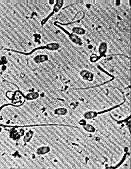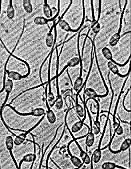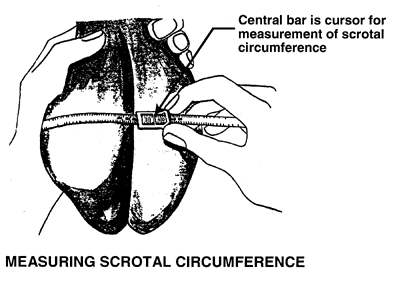

expected progeny difference (epd) | heritability | on-farm records | breeding soundness evaluation (bse) | genetics, crossbreeding, and hybrid vigor
Reproduction Related Management Issues:
Goals:
Reasonable goals for beef producers are to have a 90-95% calf crop every year and a 90-day or less calving season. Calves should weigh 500 lbs + at 205 days, and gain about 3.0 lbs. per day in a feed lot situation. A steer under intensive production should weigh 1,000 lbs + at 365 days. The information that follows can help achieve these goals.Breeding Stock Selection:
The decision on what animals to use or keep as replacement animals is a critical one. The animal’s reproductive history and reproductive potential should be major considerations when making a buy, cull, or keep decision. Because this decision is such a critical one, it should be based on sound statistical information. This information can come from performance pedigrees and Expected Progeny Difference (EPDs). It can come from records kept by the producer and from a reproductive evaluation/breeding soundness exam (BSE) performed by a veterinarian or other professional. Evaluating reproductive ability is best done by utilizing a combination of EPDs, farm records, and BSEs. The following will discuss these methods of evaluating reproductive ability and give suggestions on how to apply the results.Expected Progeny Difference (EPD) Records:
Because the reproductive ability varies greatly between different breeds of cattle and even between animals of the same breed, a producer must be aware of certain breed trends and the heritability of certain traits. For example, when compared to a Simmental, a Jersey dam on average will routinely produce a smaller calf, but have an easier time delivering. Performance sheets with EPDs and accuracy levels can be very valuable in helping to predict these genetic differences. The EPD records are kept by most of the beef breed associations and can be accessed by the internet or by contacting each breed association directly. Many performance records contain EPDs for birth weights (lbs), calving ease (ratio), weaning weights (lbs), yearling weights (lbs), scrotal circumference (cm), along with growth and milk characteristics.
Once a performance record has been obtained, the challenge comes in
understanding and applying the data. The term Expected Progeny Difference (EPD),
is a measure of the expected difference in traits the offspring from one sire or
dam will have when compared to others in the same breed. For example, a bull
with a +50 lbs. yearling weight EPD will produce yearling calves weighing 50
lbs. more than a bull with a yearling weight EPD of 0.0 lb. The other item to
consider when evaluating EPDs is the accuracy or reliability of the EPD values.
The accuracy is reported as a low of 0.0 to a high of 1.00. The higher the
number, the more reliable the sire or dam will produce the indicated EPD in the
traits of their offspring.
The table below lists various traits that can be influenced by genetics. The numbers expressed next to each trait estimate how easily or probable the particular trait will be passed on genetically. These numbers are actually the heritability of each trait and can range anywhere from 0.0 to 1.00. The higher the number, the greater the chance of passing on the trait.
Table 1:|
Trait |
Heritability |
|
Fertility |
.10 |
|
Calving ease |
.20 |
|
Birth weight |
.40 |
|
Weaning weight |
.30 |
|
Average daily gain |
.50 |
|
Feed efficiency |
.40 |
On-Farm Records:
Because many animals are not purebred and may not have EPD values calculated, on-farm records are essential in determining which animals to keep or cull. The on-farm records must be complete and accurate. The information and table below are a sample of one of these records. Specific instructions on how to calculate each desired number are also provided. Actual information for a specific cow can be recorded on page K125 of the appendix.
| Cow Number 156 . | Weaning Weight 485 . | Yearling Weight 825 . |
| Date of Birth 2/94 . | Adj. Weaning Weight 495 . | Adj. Yearling Wt. 842 . |
| Birth Weight 80 . | Weaning Ratio 104% . | Yearling Ratio 103.9% . |
| Sire #49 . | Dam #125 . |
|
Year |
Tag # |
Birth Date |
Sex |
Birth Wt. |
Age |
Wean Wt. |
1Adj. 205 Day Wt. |
2Wean. |
Age |
Yrlg. Wt. |
3Adj. |
4Yrlg. Wt. Ratio |
Sire |
|
96 |
900 |
2/12 |
F |
89 |
205 |
420 |
474 |
99.8 |
365 |
765 |
819 |
101 |
34 |
|
97 |
833 |
2/29 |
F |
81 |
195 |
410 |
462 |
97.2 |
356 |
845 |
894 |
110 |
23 |
|
98 |
566 |
2/13 |
M |
72 |
210 |
525 |
534 |
96.2 |
370 |
1054 |
1063 |
95.6 |
54 |
|
99 |
799 |
2/26 |
M |
93 |
209 |
596 |
586 |
105.6 |
363 |
1168 |
1180 |
106 |
56 |
* Calves should be weighed as close to the 205-day mark (165-245 days acceptable range) as possible. If they are weighed when they are outside of this range, the weights cannot be accurately compared to other animals.
Table 3: Weight adjustments for age of the dam (used for calculating adj. 205-day wts.)
|
Age of cow |
For female calves add: |
For male calves add: |
|
2 Years |
54 lbs |
60 lbs |
|
3 Years |
36 lbs |
40 lbs |
|
4 Years |
18 lbs |
20 lbs |
|
5-10 Years |
0 lbs |
0 lbs |
|
11 or greater Years |
18 lbs |
20 lbs |
Understanding the results:
From the information collected in table 2, the following conclusions can be made about this cow and her offspring:
* Ratios can only be used to compare animals that have similar genetics, nutrition, and environmental conditions.
Breeding Soundness Evaluation (BSE):
A breeding soundness evaluation (BSE) should be performed on every animal that is brought into a herd or is kept to be a replacement. This exam is essential for all bulls and should include the following:
Sperm Cells: Poor semen quality (left) and good semen quality (right).


This table identifies the reproductive characteristics used to identify bulls that have the potential to be good breeders:
Table 4:
|
Characteristic |
Very Good |
Good |
Fair |
Poor |
|
Scrotal Circumference by age: |
>34 cm |
>30 cm |
<30 cm |
<30 cm |
|
Semen Activity |
Rapidly swirling |
Slower swirling |
Some movement or oscillation |
Very slow or sporadic oscillation |
|
>90% normal sperm with no abnormalities |
>70% normal sperm with no abnormalities |
>40% normal sperm with no abnormalities |
<40% normal sperm with no abnormalities |
* Studies show that scrotal circumference size relates directly to quality of semen that is produced.
Use of Scrotal Circumference Tape: The testicles are pulled firmly into the lower part of the scrotum by encircling the top of the scrotum with one hand and pulling down gently on the testicles. The scrotal tape is formed into a loop and slipped over the scrotum and its contents. The tape is pulled up snugly around the greatest diameter of the scrotal contents. When weather is cold, males retract their testicles making it difficult to take proper measurements. Special care should be taken to pull the testicles into the bottom of the scrotum and eliminate any wrinkles. The thumb and fingers should be placed on the side of the scrotum, rather than between the testicles. This helps to prevent separation of the testicles and an inaccurate measurement. The circumference is measured in centimeters (cm) and is read at the point where the tape crosses the small steel crossbar on the tape thumb piece.

Other characteristics that should be considered when evaluating a bull for breeding soundness include body condition, size in relation to cows, conformation (feet and legs), testes/scrotum, penis/prepuce, and disposition. A rectal exam should be performed to evaluate the ampullae and prostate. A trichomoniasis test should also be part of any reproductive exam.
When evaluating a female cow for reproductive soundness, a thorough physical exam should be performed. This includes a rectal palpation to evaluate the cervix, uterus, uterine horns, ovaries, and pelvic diameter. Animals that have narrow pelvic diameters may have difficulty calving. Animals that are "freemartins" may not have normal reproductive organs and yet may have relatively normal looking external genitalia (vulva). Freemartins are infertile females that are born twin to a male. Replacement heifers and cows should also be examined and determined to be free of any infectious disease, not only in the reproductive tract, but elsewhere. Diseases of concern include brucellosis, vibriosis, trichomoniasis, leptospirosis, IBR, BVD, and neosporosis. An evaluation of the cow’s body condition, size in relation to bull, conformation (feet and legs), udder, and external genitalia should also be done.
Genetics, Crossbreeding, and Hybrid Vigor:
Crossbreeding is the process of mating animals from two different breeds. This mating can result in offspring that experience increased growth, better fertility, better mothering ability, and changes in other production traits. Hybrid vigor is the term used to describe this advantage to crossbreeding. Breeds that are more genetically different (like a Hereford and a Brahman) are more likely to produce hybrid vigor in their offspring when crossbred. Hybrid vigor can make those traits that have a low heritability (like fertility - see table 1 on A712) and give them a greater possibility of occurring in the crossbred offspring. Crossbreeding can be an effective tool for the producer if used in the right situations.
Summary: The decisions on what animal to buy, cull, or keep should be based on facts and if possible, past production. Economics and environmental conditions also influence these decisions. In general, one genetic trait that needs improvement in the herd should be chosen. All purchasing, culling, and replacement decisions should be made based on making this improvement. Once the trait is improved, another trait should be chosen and management decisions based on improving it should follow.
Because a bull can distribute his genetics to multiple offspring, he has a greater impact on the genetics of a herd than any individual heifer or cow. Therefore, selection of a breeding bull is one of the most important decisions a producer can make.